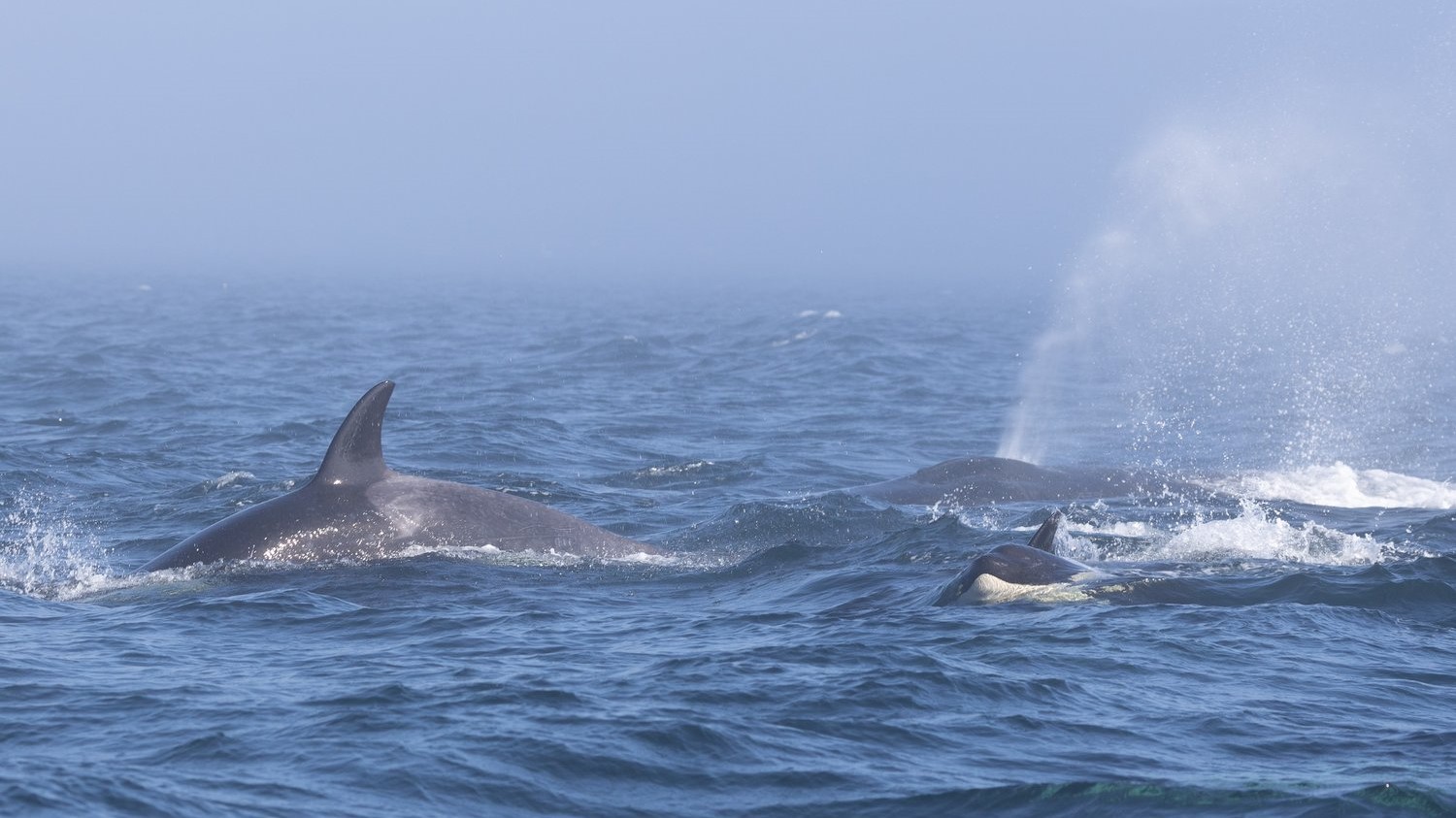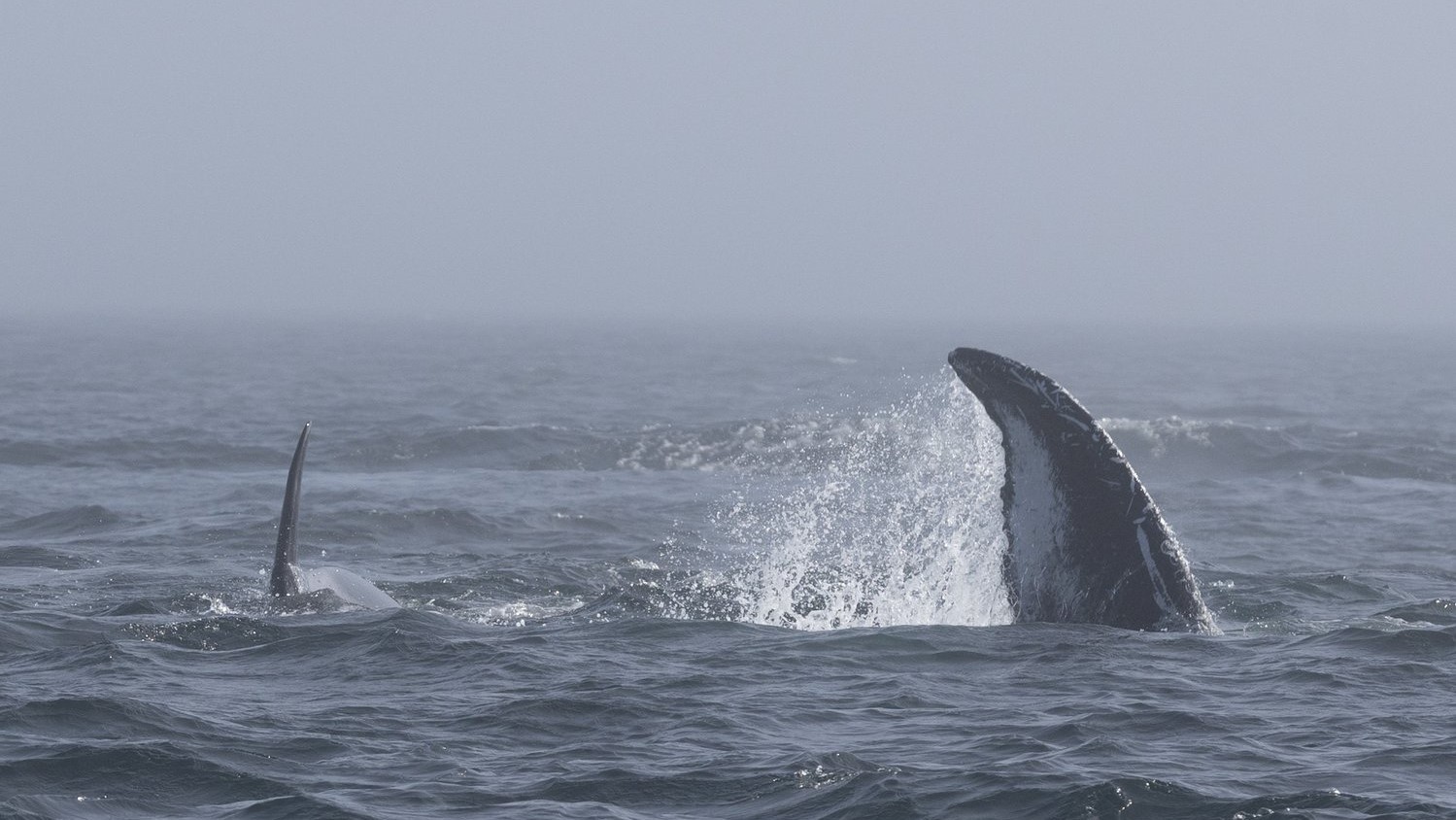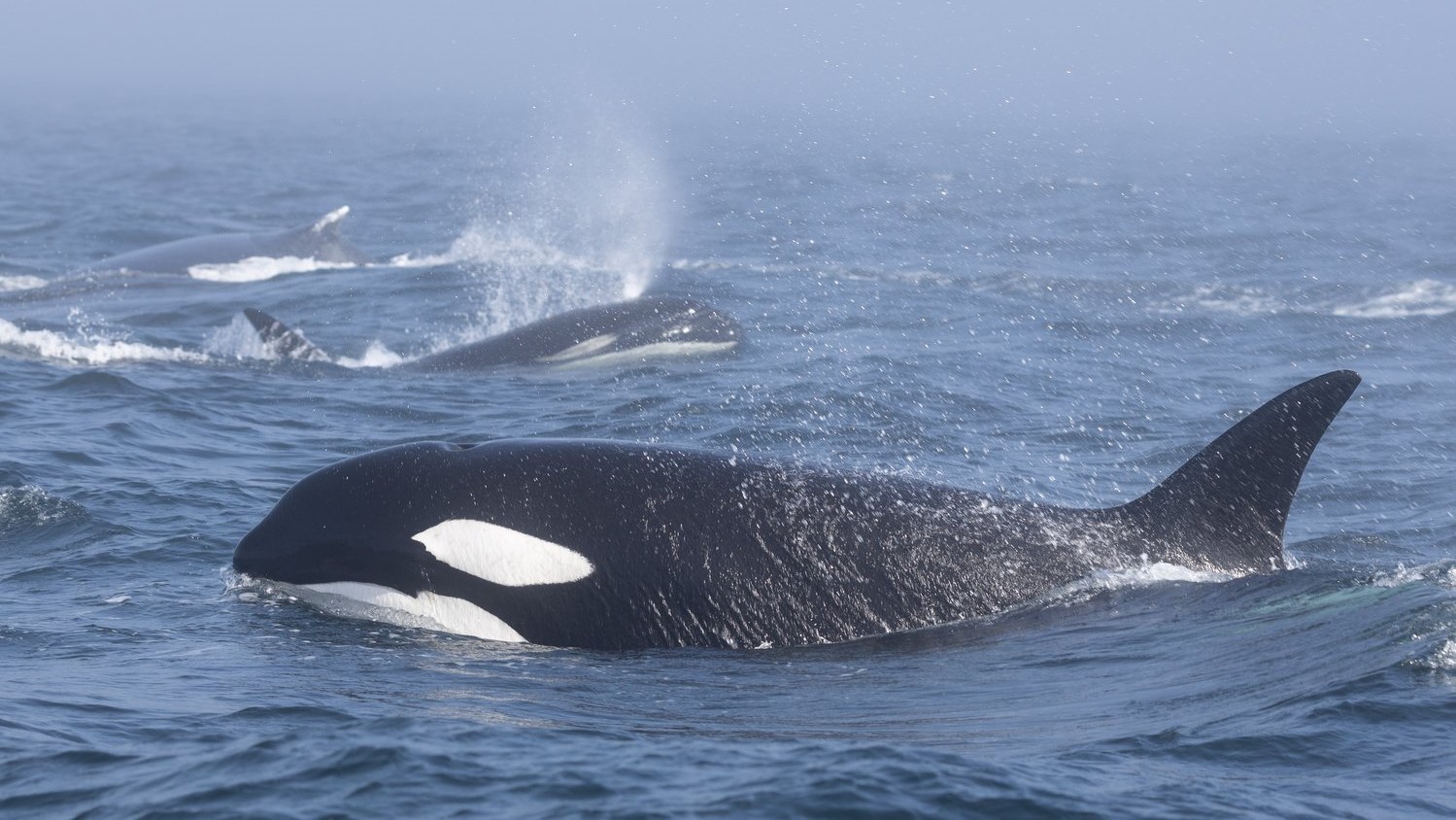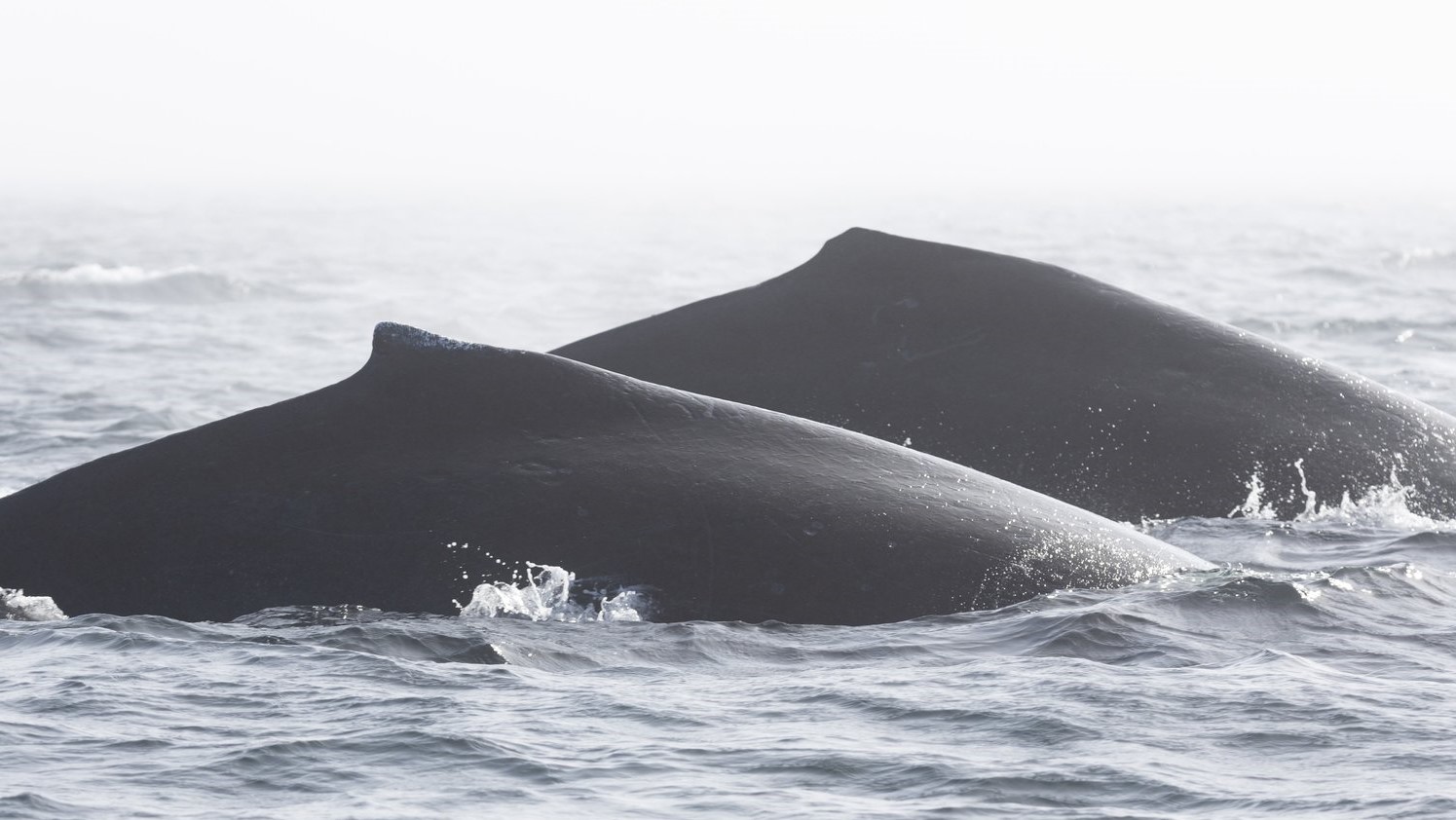Orcas and humpbacks clash in a violent melee of breaching and biting
It is unclear who won the cetacean showdown.

Whale watchers near the U.S.-Canada border recently witnessed a brutal mass brawl between more than a dozen aggressive orcas and a pair of defensive humpback whales. The intense confrontation, which lasted for several hours, included breaching, tail-slapping, biting flippers and loud vocalizations that could be heard from above the surface, according to reports. But it is unclear which species swam away victorious.
The cetacean showdown took place Sept. 29 in the Juan de Fuca Strait in the Salish Sea, which is around 25 miles (40 kilometers) west of Victoria, British Columbia and Port Angeles, Washington, representatives of the Pacific Whale Watch Association (PWWA) said in a statement. Crew members aboard an Eagle Wing Tours whale watching boat first spotted around 15 "unusually active" orcas, or killer whales (Orcinus orca), at the surface. Spectators onboard a nearby BC Whale Tours vessel soon noticed what was causing the orcas to act up — a pair of female humpback whales (Megaptera novaeangliae).
Throughout the day, various onlookers, including whale watchers onboard a Sooke Coastal Explorations boat, witnessed the progression of the unusual altercation, which lasted for at least three hours. However, whale watchers eventually lost sight of the epic encounter when a thick cloud of fog rolled in, so the result of the contest remains a mystery.
"I'm still trying to wrap my head around it because it was absolutely unbelievable," Mollie Naccarato, captain of the Sooke Coastal Explorations vessel, said in the statement. "At first the orcas seemed to be chasing the humpbacks, but then when it seemed there was space between them, the humpbacks would go back toward the orcas."
Related: In rare wildlife encounter, whale watchers spot two white killer whales off Japan
Some of the orcas from the group were identified as individuals from three factions of transient killer whales; the T109As, T233s, and the T252s, which are frequently seen in the area. Transient orcas, also known as Bigg's killer whales, are an ecotype of killer whales — a kind of sub-species that is geographically distinct from the rest of its species. Unlike resident killer whales, which remain in large groups tied to a specific area, transient orcas form small groups and roam across a wider area and are known to be much more aggressive than other orcas.
The humpbacks were also identified by their tag numbers: BCX1948, also known as Reaper, and BCY1000, also known as Hydra. Reaper is a 4-year-old juvenile female known to spend the winter at breeding grounds off Jalisco, Mexico, and Hydra is an adult female known to migrate to Maui, Hawaii, where she’s given birth to at least three calves in her lifetime. If they survived the encounter, the humpback pair are due to begin their annual migration within the next few weeks, according to PWWA.
Sign up for the Live Science daily newsletter now
Get the world’s most fascinating discoveries delivered straight to your inbox.

"Around these parts, it's very common for us to encounter orcas. It's also very common for us to encounter humpbacks," Erin Gless, executive director at PWWA, told CBC News. "It is not very common for us to encounter them in the middle of a brawl."
Bigg's orcas normally prey on smaller marine mammals such as seals, sea lions and porpoises, but have also been known to hunt larger whales like humpbacks, which makes them the only natural predators of humpbacks in the area, according to PWWA.
"Even though humpback whales can get to be the size of a school bus, a group of very experienced hunters can [still] attack them," Gless said. However, it can sometimes be unclear if these attacks are predatory or territorial, she added.

PWWA vessels have never directly observed orcas killing a humpback whale in the Salish Sea, but interactions between the two species have been on the increase in the region after humpback whale populations recently rebounded, following a severe decline brought about by historic whaling.
In May 2021, a group of 13 orcas similarly attacked a humpback mother and calf in the Salish Sea. Onlookers at the time believed that the baby whale had been killed, but there was no direct evidence of this.
"With the return of the humpbacks in the Salish Sea after being hunted close to extinction we are seeing a lot more interaction between humpbacks and killer whales," Mark Malleson, a marine biologist at the Center for Whale Research in Washington, told Live Science at the time. But observed interactions of the two species could also be on the rise because there are "more eyes on the water" due to an increase in whale watching vessels in the area, he added.
In February 2021, a young male humpback barely managed to survive a 4-hour attack from orcas in Australia, but lost its dorsal fin in the process.
All of these violent encounters have one thing in common — at least one of the humpbacks was a calf or juvenile. And that is no accident, said Erich Hoyt, a research fellow at Whale and Dolphin Conservation (WDC) in the U.K. and author of the book "Orca: The whale called killer."

"Orcas will attack younger humpback whales and sometimes get lucky," Hoyt told Live Science in an email. "But if there is an older individual around, particularly a female, it’s not often successful."
Female humpbacks will also go on the offensive and attack orcas with vicious tail slams to protect younger whales and even to defend other species, such as seals or porpoises, Hoyt said. This isn't seen very often in the Salish Sea "but in places like Antarctica, where you get overlap between the two species, killer whales give the large female humpbacks a wide berth," Hoyt added.
Related: Breaching humpback whale body slams boat in Mexico, injuring everyone on board
However, interactions between the two species are not always so hostile.
In January 2021, a pod of orcas freed a humpback whale who had become tangled up in ropes, although scientists don't know if this was true altruism or a botched predation job.
Killer whales also target other surprising marine megafauna, which more than earns them their sinister names.
In March 2021, a massive group of around 70 orcas managed to collectively take down a blue whale (Balaenoptera musculus) off the coast of Australia.
And in June this year, a new study revealed that a pair of orcas in South Africa are responsible for killing at least eight great white sharks (Carcharodon carcharias) by ripping out their energy-rich livers.

Harry is a U.K.-based senior staff writer at Live Science. He studied marine biology at the University of Exeter before training to become a journalist. He covers a wide range of topics including space exploration, planetary science, space weather, climate change, animal behavior and paleontology. His recent work on the solar maximum won "best space submission" at the 2024 Aerospace Media Awards and was shortlisted in the "top scoop" category at the NCTJ Awards for Excellence in 2023. He also writes Live Science's weekly Earth from space series.











